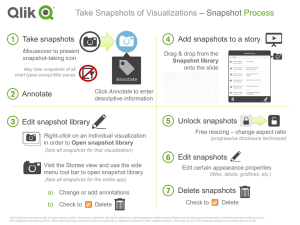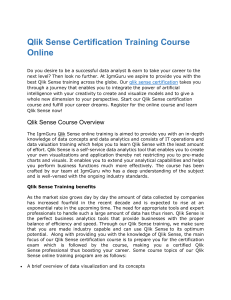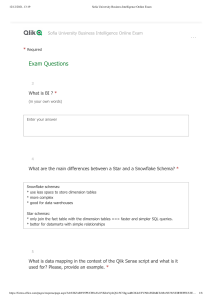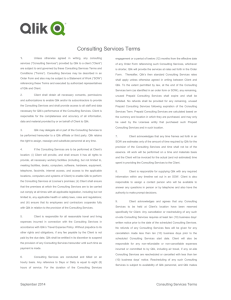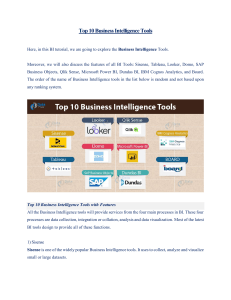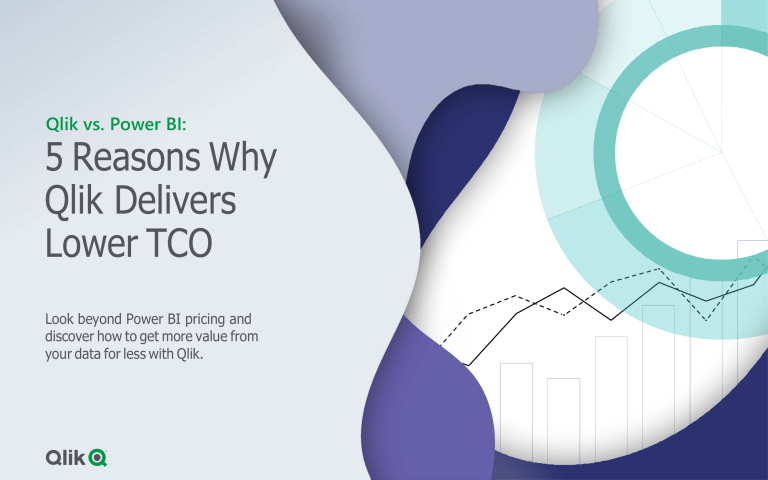
Qlik vs. Power BI: 5 Reasons Why Qlik Delivers Lower TCO Look beyond Power BI pricing and discover how to get more value from your data for less with Qlik. What does it actually cost to own a BI solution? Many companies only consider the initial purchase price when choosing a BI platform. But total cost of ownership (TCO) is much more than that. From buying the software and infrastructure, to deployment and integrations, to support and maintenance, some platforms demand a much bigger financial – and time – commitment. When it comes to choosing the best solution for your organization, these five considerations should top your list: ✓ Complexity ✓ Self-service ✓ Governance ✓ Scalability ✓ Cost predictability Qlik vs. Power BI: 5 Reasons Why Qlik Delivers Lower TCO | 2 The real TCO TCO includes the cost of purchasing and owning a BI solution for at least 3 to 5 years. SOFTWARE INFRASTRUCTURE • Software licenses • Cloud data storage • SaaS subscription • Processors, memory, compute • License maintenance storage, transactions, and networking SYSTEMS SETUP AND APP DEVELOPMENT SYSTEMS ADMIN AND SUPPORT • Up-front server deployment • BI, IT, and data literacy support for users and configuration • Data connections and modeling • Reports and dashboard development • Applying upgrades and patches, troubleshooting, and performance monitoring • Service subscriptions Qlik vs. Power BI: 5 Reasons Why Qlik Delivers Lower TCO | 3 1. Complexity To solve real-world business problems, you’ll need more than just data visualization. Your BI solution must be robust enough to handle your visualization and broader data and analytics needs – without driving up TCO. POWER BI Complex setup and maintenance If you want Power BI to do more than just simple visualizations, buckle up for a complicated (and expensive) ride. You’ll need to configure several products across desktops, servers, and cloud – and maintain and support them all – which means higher TCO. Power BI report development and data modeling are done on desktop tools that have to be downloaded to a desktop computer or laptop and maintained. Certain integrations, like on-premise data, require a heavy and unreliable data gateway. Want to run your BI on the cloud? Your only choice will be to get locked into Azure. QLIK Easier to get up and running Qlik® is a complete BI platform that runs on the cloud, making it faster and easier to set up. With Qlik, things like data prep and app development are done via the web, so there’s no need to download or maintain tools to your desktop or laptop. SaaS with Qlik is also 100% cloud based, so you can avoid having to download products across desktops, servers, and cloud. And, Qlik runs on your preferred cloud solution, like AWS, Azure, Qlik’s, or any other. Qlik vs. Power BI: 5 Reasons Why Qlik Delivers Lower TCO | 4 Whoa, Power BI – that’s a lot of components. QLIK IS A MUCH LIGHTER LOAD Data Sources Qlik Sense Enterprise Qlik Sense Enterprise SaaS or client-managed Web browser Content creation • Centralized data load, prep, and modeling • Calculations and visualizations • Content distribution, sharing, Web browser Content consumption and collaboration Power BI ADMIN Data Gateway Azure Analysis Services Power BI Power BI Premium VMs or servers (SQL Srv Analysis Services) Desktops (Power BI Service) • On-premise data sources • Centralized data load, prep, • Per developer, laptop install modeling, and calculations • Content distribution, sharing, and collaboration • Data load, prep, and modeling ADMIN • Calculations and visuals ADMIN ADMIN Laptops Power BI Report Server • Separate executables for VMs or servers + SQL server Service vs. Report Server Web browser Content consumption • On-premise content distribution server ADMIN ADMIN Qlik vs. Power BI: 5 Reasons Why Qlik Delivers Lower TCO | 5 Number of support and maintenance FTEs is at least 1.7x higher for Power BI 2. Self-service Businesses are facing an explosion of available data and want to be more data driven, but the traditional self-service approach that only enables power users isn’t enough. It is vital to extend self-service to all users: power users, developers, and technical and nontechnical users. A BI solution that helps all users understand, analyze, and use data with confidence – plus answer their own questions – not only boosts data-driven transformation, it improves data literacy and reduces dependency on overloaded IT resources. Which results in lower TCO. POWER BI High dependency on (limited) IT resources To create a report in Power BI, non-technical users or consumers rely heavily on technical experts and report developers. And, thanks to data restrictions, reports lack depth and interactivity. Query-based tools like Power BI require SQL programming skills. SQL queries load subsets of data predetermined in the design phase – so when new questions come up later, consumers must go Power BI back to IT for new reports. With Power BI, users need to know DAX, M, and MDX – well beyond the skill set of most nontechnical users. QLI1K.7 Self-service for all users Qlik has always empowered both technical and nontechnical users to freely explore data, catering to different skill levels. We call Qlik it “data democracy.” Our unique Associative Engine lets all users broadly explore data on a level not possible with other tools, so there’s far less need to author reports. Our industry-leading AI capabilities and interactive charts boost non-technical users’ ability to ask and answer their own questions without having to rely on intervention from power users. So with Qlik, consumers rely less on IT and contribute more to your organization’s success. Qlik vs. Power BI: 5 Reasons Why Qlik Delivers Lower TCO | 6 3. Governance A data democracy is only as good as its data governance. Without it, data users cannot fully trust their BI, and they open your business up to security risks. But with a properly governed framework, users can share created content – making everyone more efficient. POWER BI Limited governance and reuse Imagine hundreds or even thousands of data users, each with their own version of Power BI Desktop on their laptops. They each have their own connections to data sources, and they might even have sensitive data stored locally on their laptops. Governing all that data is tricky and time-consuming. Plus, the lack of self-service capabilities can force IT and developers to give everyone an editable copy of each Power BI report. But this leads to report sprawl, high governance costs, and multiple versions of the truth. QLIK Number of desktop authoring tools across an organization Power BI: dozens to thousands Qlik: zero Advanced governance and reuse Qlik’s governance capabilities and unique approach enable governed self-service. The web-based platform gives IT visibility and centralized control on data provisioning, along with more granular data access controls. What’s more, Qlik developers and analysts can create apps that serve as platforms for governed data sharing. For example, Qlik lets consumers of BI content create their own sheets and visuals on top of a published Qlik app and dataset, leveraging a governed library of business logic built into the app. Qlik vs. Power BI: 5 Reasons Why Qlik Delivers Lower TCO | 7 4. Scalability The amount of data available is growing exponentially. But it won’t do your organization any good unless you can use it. And if you choose a BI solution that requires adding capacity too soon or too fast, then it will not scale well – and will end up costing you more. POWER BI QLIK Scalability – at a cost Super scalable Is your Power BI report bigger than 1GB? You’ll need to build an external data When it comes to scalability, Qlik outperforms the competition. It’s fast and cost- repository for live query – or upgrade to Power BI Premium. What if it’s 2GB? 3GB? effective for smaller deployments, and its architecture scales economically from Or more? Then you’ll need higher Power BI Premium capacities that will add more megabytes to terabytes of data in large global enterprise deployments. Qlik’s costs. Is your Power BI report too slow to load? You’ll need to break it up into smaller unique in-memory Associative Engine supports more concurrent users without any pieces – or use other workarounds. And as data volumes and user adoption grow, loss of performance. This means customers can do more with less capacity – thus Power BI’s query-based reporting will constrain scalability and report performance. lowering your costs. Need incremental loads? More than eight data refreshes a day? How about advanced collaboration? Again, you’ll need to buy Power BI Premium. How much does that “power” in Power BI cost? Power BI Premium per user: $20/month/user Power BI Premium P1 node: $5,000/month Power BI Premium P3 node: $20,000/month Qlik vs. Power BI: 5 Reasons Why Qlik Delivers Lower TCO | 8 5. Cost predictability Data user needs and technology will evolve over time. Successful buyers examine the gritty details in order to choose a BI solution that avoids hidden costs and future-proofs their investment. POWER BI Surprise costs To add capabilities and users to Power BI, you need to buy extra products, licenses, and capacity. For example, if you want to access on-premise sources, you’ll need Data Gateway servers, infrastructure, and Microsoft Express Route for a secure connection. Need to deploy data marts or warehouses? You’ll probably need an SQL server, possibly Analysis Services or Azure Synapse. Have a lot of users viewing reports and dashboards, and need consistent query performance and higher refresh frequency? You’ll need Power BI Premium and possibly Express Route – even if you already own Power BI Pro licenses. And if you want content physically stored closer to your users, you’ll need multiple Power BI Premium nodes in each region. QLIK Total cost transparency Qlik’s pricing transparency gives customers a clear view of all costs upfront. With our simple subscription license model, you’ll know exactly what you’re getting, right out of the gate – no surprises (except for what you might find in your data). Qlik’s roadmap and pricing strategy future-proofs against large unplanned costs, even as you add users. Qlik vs. Power BI: 5 Reasons Why Qlik Delivers Lower TCO | 9 Year after year, Power BI costs 30% more (Scenario for 100 Users). And Power BI’s surprise costs just keep coming. $1,386 Cost per User per Year SQL server: $15,000/core Express Route: starts at $60,000/year for 1Gbps connection Licenses + Infrastructure + Dev + Maintenance Power BI $1,054 Licenses + Infrastructure + Dev + Maintenance Data Gateway infrastructure: starts at $7,000 Power BI Premium P1 node: $60,000/year Power BI Premium P2 node: $120,000/year Power BI Premium P3 node: $240,000/year Qlik Sense Qlik vs. Power BI: 5 Reasons Why Qlik Delivers Lower TCO | 10 Qlik has a lower TCO, no matter the deployment size. Enterprises today need an analytics solution that empowers all users across the entire organization with self-service capabilities, whatever the data source. Unlike vendors that dictate a cloud strategy and leave little flexibility for their customers, Qlik offers flexible deployment options and provides an array of modern capabilities and higher scalability – all with lower complexity in architecture and licensing. Our unique approach gives data users the flexibility, elasticity, and portability that modern analytics demands. And that means better insights – and lower TCO – for your business. But don’t just take our word for it. Analyze Qlik Sense Business for yourself. Start Free Trial Qlik vs. Power BI: 5 Reasons Why Qlik Delivers Lower TCO | 11 ABOUT QLIK Qlik’s vision is a data-literate world, where everyone can use data and analytics to improve decision-making and solve their most challenging problems. Our cloud-based Qlik Active Intelligence Platform delivers end-to-end, real-time data integration and analytics cloud solutions to close the gaps between data, insights and action. By transforming data into Active Intelligence, businesses can drive better decisions, improve revenue and profitability, and optimize customer relationships. Qlik does business in more than 100 countries and serves over 38,000 active customers around the world. qlik.com © 2021 QlikTech International AB. All rights reserved. All company and/or product names may be trade names, trademarks and/or registered trademarks of the respective owners with which they are associated.
